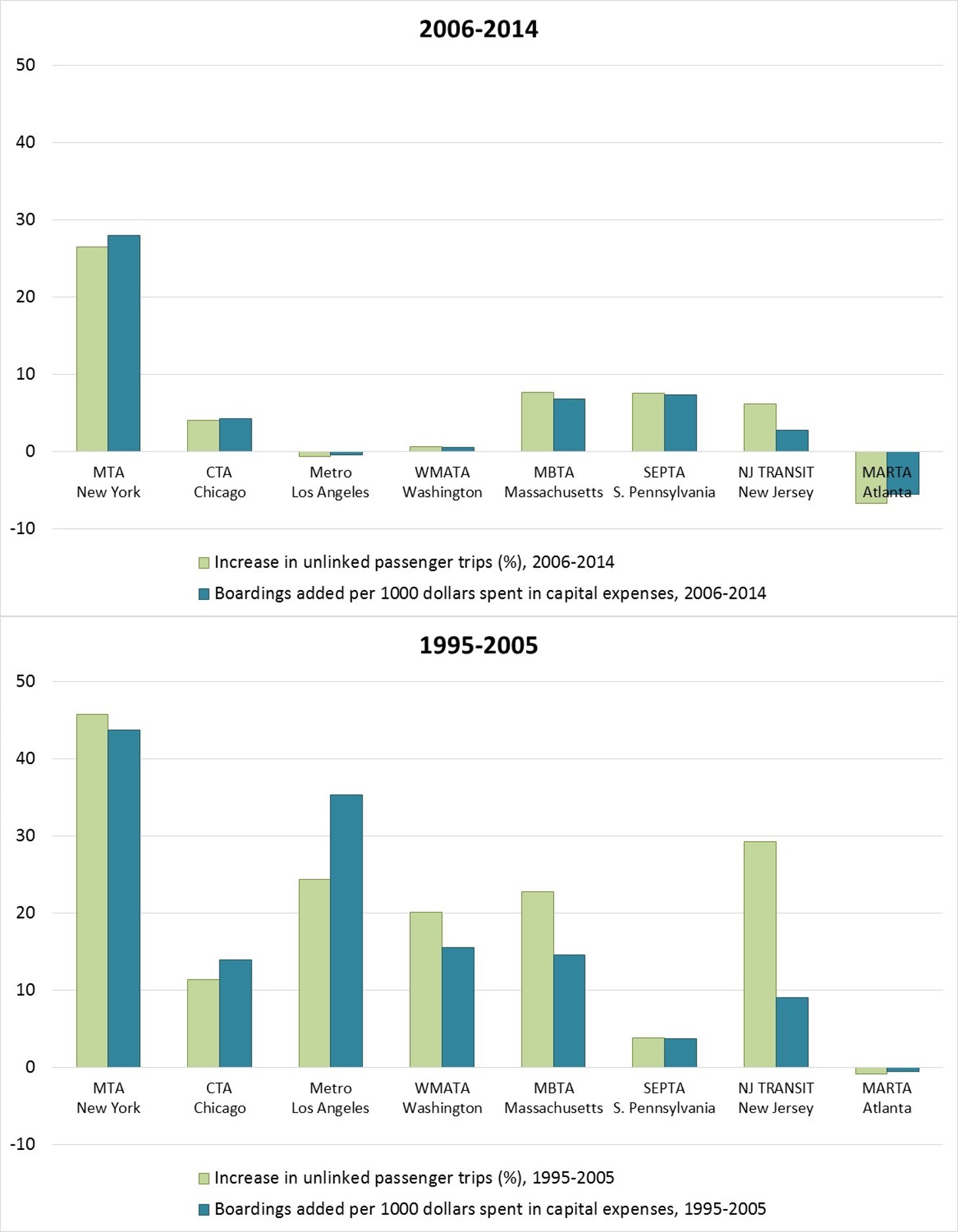Blog
Stop the VideoResearch Projects

It's Time to Rethink Transit Planning in Los Angeles
Posted 9/4/2016 by METRANS

The LA Times study highlights that most public transit agencies in Southern California, including Metro, the largest regional carrier, have experienced declines in passenger boardings between 2006 and 2015. For some agencies, the loss looks quite dramatic. This is a problem because the agencies have all made substantial investments, with public dollars, over that period for expanding and improving their service, and Metro has spent $9 billion for its light rail and subway projects. So, it’s not unfair to ask whether Metro et al. have simply poured all our hard earned money down the drain, and consider whether we should support future transit programs. I don’t think, however, that the numbers – those presented in the LA Times report – can alone be used to address the questions.
Surveys show that public transit has (for a long time, and certainly over the 1985-2015 period studied in the report) and continues to largely serve those without the means to own or operate a private vehicle in the U.S. Surveys also show that when transit-dependents get access to a car, many (or most) embrace the opportunity and happily leave the transit market. Over the years, automobile technology has improved significantly without any significant increase in driving costs, and the auto mode has probably experienced a lot more innovation than transit. Congestion has definitely grown worse, but is not "bad enough" for most people to reject the car, and the sum total of all auto travel costs for any traveler making any trip, on average, is still much lower than the costs (including unpredictability and inconvenience associated with making transfers and walking to/from stations) of transit travel, even after billions of dollars of investments in transit across the U.S. Parking continues to be free, and buses and trains still cannot take us anywhere we want to go at any time of the day. The National Household Travel Survey shows that transit trip share (i.e. unlinked public transit trips as a fraction of all trips) has declined in 24 out of 25 largest transit markets (metro areas) in the U.S., including Los Angeles, over the past decade. National Transit Database figures show that the U.S. transit industry is getting more and more unproductive, requiring more and more subsidies. Declining transit use in spite of continued system improvements has been a national issue for a long time now, and I don’t see any reason to be particularly alarmed by the LA Times numbers.
There are many ways to assess transit use and productivity. Number of passenger boardings, or the number of unlinked passenger trips, is just one of them. Trend analysis using boarding counts can be misleading if the underlying population changes over time. We therefore need a denominator. Transit boardings per capita, across an urban area or within a given operator’s service area, is definitely a better measure. If the LA Times report had used such a measure, the outcome would have been different, probably more alarming, I think, for most Southern California transit agencies.
But we must also recognize that boarding counts or boardings per capita can drop, although only marginally, if agencies reorganize their systems to connect more passengers with their destinations directly, minimizing transfers per trip on average. We need to account for that effect. And we must also consider what would have happened if the transit agencies had not made these very large investments. Did agencies, here in Southern California and across the U.S., manage to prevent an even bigger drop in ridership? We don’t know. We can’t deny that competition in the travel market is stiff (and getting stiffer with advances in information and communications technologies), and "if we don’t build it, they (the existing patrons) will suffer and then leave at the first opportunity" and "if we build it well, very well, they (those with choice) may or may not come." The question is how transit agencies strike a balance, given the politics of transit funding and auto subsidies. It’s hard.
I did some quick number crunching, and it seems to me that Metro, the transit powerhouse of the Southern California region, has not made great decisions over the 2006-2014 period. See Figure 1 (top panel). Over the period, and in the group of the largest U.S. transit agencies in terms of their 2014 ridership (unlinked passenger trips or UPT), Metro has had one of the lowest increases in both UPT (as % - in fact a decrease) and in the number of boardings added (again, a decrease) per dollar spent in capital expenses. One can argue that Los Angeles is different and that it is far more challenging to plan for transit, and to attract and retain riders here. But the public can question, and Metro needs to have a good explanation. The 1995-2005 period, however, was different. See Figure 1 (bottom panel). In this period, just after most of the Metro rail network was built, Metro experienced a substantial increase in ridership and yield compared to its peers. Does that mean Metro is doing the right thing by building more rail in the region? I don’t think the answer is an easy "yes." It’s all about building the right service in the right place at the right time.
Figure 1: Large U.S. public transit agencies – ridership growth and yield

Author’s analysis using data from the US National Transit Database (www.ntdprogram.gov)
Top Panel: 2006-2014; Bottom Panel: 1995-2005
But I still think that continuing to invest in transit is important. Transit is a key piece of multi-modal transportation networks across major global cities, and U.S. metros should have world-class transit networks too. Transit needs to enter the choice-set of travelers with choice, and it must provide good service for those who depend on it. I understand that many U.S. cities, including Los Angeles, are different from Asian and European cities, but that does not mean we should not support good transit investments. All we need to do is think about and plan for transit differently, and more prudently. In Los Angeles, for example, we cannot run empty trains along convenient corridors over long distances hoping that we will have riders someday. We cannot have transit-to-auto travel time ratio over four on average. We cannot allow buses to run late for over a third of their trips during peak hours. We cannot allow frequent service disruptions and blast information. We cannot have patrons waiting for buses without shade and in hazardous locations. The list can go on, and on. There are so many things that we need to, and can fix. And we should realize (I know that everybody realizes now) that investing in transit alone is not enough for getting people to use it. We need to remove unjust subsidies for auto travel by reforming the gas tax, rethinking parking policy, implementing road use charges, etc. And then we need to decide, really decide without any predispositions, about whether we need bus or rail, and also find ways to finance transit improvements and carve out service policies that can help serve more patrons than voters. Declining transit ridership is a problem, and planners must think creatively, and use the power of technology effectively, to solve it.
Sandip Chakrabarti
Sandip Chakrabarti, Ph.D. is a Research Associate at the USC METRANS Transportation Center. His research focuses on the analysis of land use-transportation interactions, travel behavior, public transit planning and operations, multi-modal system performance measurement and monitoring, and impact analysis of new transportation investments. Dr. Chakrabarti has been working on the Archived Data Management System (ADMS) project funded by the Los Angeles County Metropolitan Transportation Authority since 2010. He is involved in the development of a unique historical archive of real-time multimodal transportation system data, and its application in urban transportation planning, operations, and management. Sandip is also currently studying the decline in inter- and intra-urban population mobility in the U.S., and analyzing its impacts on passenger travel.















